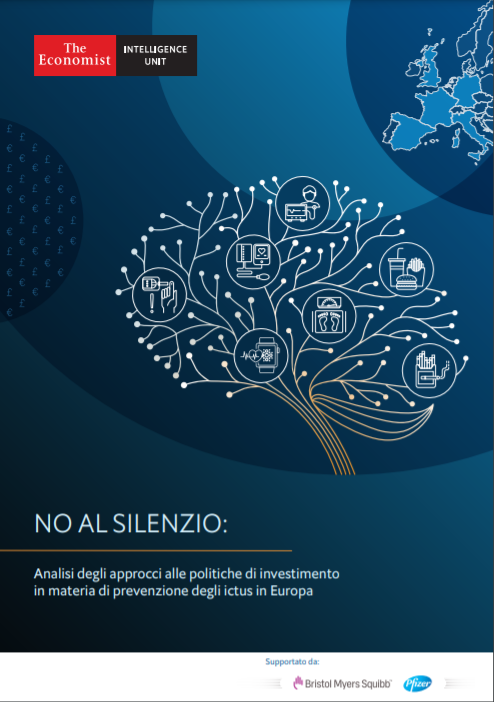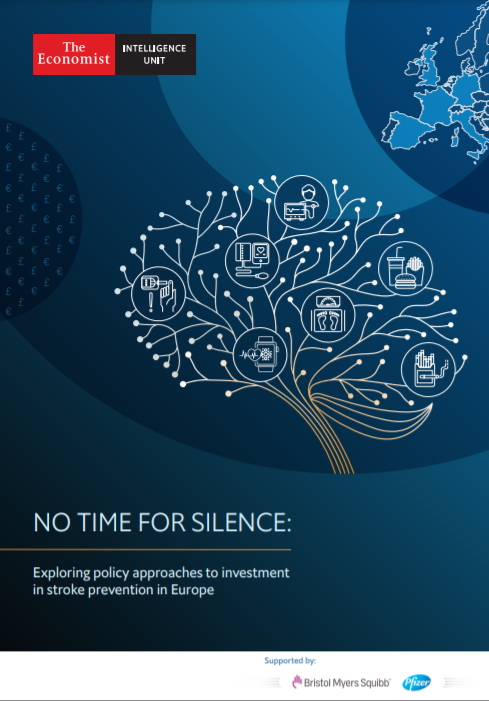No time for silence: exploring policy approaches to investment in stroke prevention in France, Germany, Italy, Spain and the UK is an independent report written by The Economist Intelligence Unit, sponsored by The Bristol Myers Squibb–Pfizer Alliance. The report considers policy and investment efforts around best practices for preventing stroke including resources for education, awareness and detection. To better understand variations in European policy, the research has been conducted across five major countries: France, Germany, Italy, Spain and the UK.
The report’s findings are informed by a survey of more than 250 senior executives in patient advocacy groups, the healthcare workforce and healthcare policymakers and payers (public and private). All respondents’ work involves prevention and management of stroke and/ or the financing of services to prevent or manage stroke. Respondents are equally representative of the five target countries. (See Appendix: About the survey for more information.)
In addition, the following individuals (listed alphabetically) have generously contributed their views and insights to this report; The Economist Intelligence Unit extends its gratitude to:
- Julio Agredano, founder and president, Fundación Freno al ICTUS, SPAIN
- Yannick Béjot, head of general, vascular and degenerative neurology department, Dijon Stroke Registry (EA7460), University Hospital of Dijon Bourgogne, FRANCE
- Valeria Caso, past-president of the European Stroke Organisation, University of Perugia Stroke Unit, ITALY
- Antonio Di Carlo, first researcher, Institute of Neuroscience, Italian National Research Council, ITALY
- Miquel Gallofré, former director of stroke programme, Health Department, Autonomous Government of Catalonia, SPAIN
- Maurice Giroud, Department of Neurology, University Hospital of Dijon Burgundy, Dijon Stroke Registry (EA 7460), FRANCE
- Trudie Lobban, founder and CEO, Arrhythmia Alliance, UK
- Massimo Piepoli, chair, European Association for Cardiovascular Prevention and Rehabilitation, ITALY
- Markus Wagner, senior expert, German Stroke Foundation (Stiftung Deutsche Schlaganfall-Hilfe), GERMANY
- Jamie Waterall, deputy chief nurse and chair of England’s Cardiovascular Disease Prevention System Leadership Forum, Public Health England, UK
Executive Summary
The economic burden of stroke is increasingly taxing on European countries. Despite rapid reductions in stroke rates and improvements in preventative measures, demographic changes mean the absolute number of stroke incidence is on the rise. But most strokes can be prevented, and the current high healthcare costs can be significantly reduced with more effective policy responses and investment in prevention activities.1
To assist policymakers, healthcare providers and payers in creating a better policy framework for stroke prevention, this report explores how five European countries currently perceive and act on their policy and investment. And to better understand policy impact and where further progress can be made, this research is combined with the perspective of on-the-ground experts active in stroke prevention and management strategies.
This report builds on a research paper produced by the Economist Intelligence Unit for the Bristol Myers Squibb–Pfizer Alliance in 2017, Preventing Stroke, Uneven Progress, 2,3 and conducts deeper analysis of these five countries through a survey and in-depth interviews.
The key findings of the research are:
- Stroke rates are declining across Europe. This is due in part to healthy living advice and better clinical interventions to manage risk factors like high blood pressure, cholesterol, atrial fibrillation (AF), weight management and smoking. To go further, governments need to be more strategic in how they support other effective interventions proven to reduce the risk of stroke. A large majority of survey respondents (84%) agree that more investment in prevention now will help reduce healthcare system costs in the long term.
- Even as Europe’s average stroke rates and national stroke rates decline, these figures mask inequalities. Based on our research, each European country in our study could make significant improvements to deal with regional inequalities. More negative stroke outcomes are found among poorer and deprived populations across the board. Experts argue that equitable distribution of care and resources alongside better implementation of local, regional and national guidelines will be a critical focus in ongoing and future efforts to reduce stroke
- Most respondents believe the government has a greater role to play in funding stroke prevention. Most (60%) of our survey respondents think government funding in stroke prevention is lacking to prevent admissions to emergency hospital departments in the long term, particularly in Germany (69%). Although Italy, which frequently emerges as an exception, notably feels otherwise (39%).
- Education and awareness initiatives need greater funding and support from government. Most strokes can be preventable, and prevention is far less expensive than acute care and long-term care following a stroke.4 Unfortunately, the majority (71%) of respondents do not think many people understand the impact of stroke and how it is a leading cause of disability. If European Stroke Organisation goals of 10% reduction in absolute strokes are to be met,5 the general population needs greater understanding of stroke as a medical emergency and how they can modify atherosclerotic risk factors.6 Many effective campaigns like “know your pulse” and “know your cholesterol” exist,7,8,9 and survey respondents agree they will only become more important in the future. But interviewees say such campaigns are largely funded privately and insufficiently. To make a wider impact, more government funding is necessary.
- Clinical guideline implementation can be dramatically improved. Only 39% of respondents believe the latest clinical guidelines for managing people at risk of stroke are being “mostly” or “entirely” implemented. At best, 48% of respondents in Italy feel guidelines are “mostly” or “entirely” implemented, while in Spain the figure is just 31%. Lack of funding from national authorities and a lack of understanding of key stroke risk factors are the largest barriers to implementation, according to respondents.
- General practitioners, specialists, nurses and pharmacists have a bigger role to play. Looking to the future, survey respondents say GPs, specialists and nurses will have a significantly greater role in detecting and managing stroke risk factors and generally increasing awareness among patients. However, pharmacists and patient groups are generally overlooked as potentially more active players, bringing into question if the most on-the-ground stakeholders that could be involved in prevention are being fully utilised.
- More digital investment and support from government is important for future prevention. The uptake of digital tools like apps and smart watches to detect and monitor stroke risk factors is on the rise, along with a proliferation of available devices. As adoption grows so does the demand for greater involvement and support from government. This includes data protection and adoption of unified standards so that records can be shared across the healthcare spectrum. Most experts feel governments have a growing role to play in digital health technology regulation and in encouraging their uptake for stroke prevention.
 |
 |
| Download Italian Report | Download English Report |
[1] “Stroke Action Plan Europe 2018-2030”, European Stroke Organisation, May 23rd 2018. https://eso-stroke.org/action-plan-strokeeurope-2018-2030-2/
[2] “Preventing Stroke: Uneven Progress”, The Economist Intelligence Unit, 2017. https://eiuperspectives.economist.com/healthcare/policyapproaches-stroke-prevention/white-paper/preventing-stroke-uneven-progress
[3] A Karnad, A Pannelay, A Boshnakova et al., “Stroke prevention in Europe: how are 11 European countries progressing toward the European Society of Cardiology (ESC) recommendations?”, Risk Management and Healthcare Policy, Vol.11, 2018, pages 117-125. https://www.ncbi.nlm.nih.gov/pmc/ articles/PMC6112781/#!po=75.0000
[4] “Stroke: Healthy living”, Centres for Disease Control and Prevention, January 31st 2020. https://www.cdc.gov/stroke/healthy_living.htm
[5] B Norrving, J Barrick, A Davalos et al., “Action Plan for Stroke in Europe 2018–2030”, European Stroke Journal, 2018. https://actionplan.eso-stroke. org/images/2396987318808719.pdf
[6] “Stroke Action Plan Europe 2018-2030”, European Stroke Organisation, May 23rd 2018. https://eso-stroke.org/action-plan-strokeeurope-2018-2030-2/
[7] “Know your pulse” campaign, Arrhythmia Alliance. https://www.heartrhythmalliance.org/aa/uk/know-your-pulse
[8] “Mujeres por el corazón”, Fundacion Mapfre. https://www.fundacionmapfre.org/fundacion/en/programs/health/mujeres-por-el-corazon/
[9] Heart UK’s National Cholesterol Month. https://www.heartuk.org.uk/national-cholesterol-month/national-cholesterol-month





